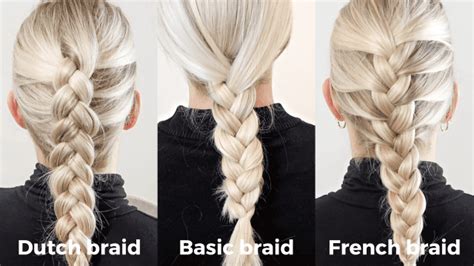Dutch Braids: The Intricate Elder Sister
Dutch braids, also known as “inside-out” braids, are a classic and versatile hairdo that has captivated hair enthusiasts for centuries. Originating in the Netherlands, these braids have become a staple in hairstyling, gracing heads from runways to everyday life.

Construction: Dutch braids are created by separating three strands of hair near the crown and crossing the right strand under the middle strand, followed by the left strand under the newly formed middle strand. They are then secured in an upward or downward direction.
Benefits:
- Volume and texture: Dutch braids instantly add volume and texture to hair, making them a great option for fine or flat hair.
- Durability: Dutch braids are known for their resilience, lasting for days without unraveling. They are perfect for active lifestyles or extended hairdos.
- Versatility: Dutch braids can be styled in various ways, from a single braid running down the center to multiple braids forming intricate designs.
Drawbacks:
- Complexity: Dutch braids require more skill and practice to master than French braids.
- Tension: Dutch braids can put strain on the scalp, especially if they are pulled too tightly.
- Limited hold: Dutch braids may struggle to hold long, thick hair in place without additional products or techniques.
French Braids: The Sophisticated French Cousin
French braids, a beloved hairdressing technique for over a century, are characterized by their elegant and intricate appearance. They have graced the heads of royalty, celebrities, and fashion icons alike.
Construction: French braids are created by dividing the hair into three equal strands near the crown. The right strand crosses over the middle strand, followed by the left strand crossing over the new middle strand. A small section of hair is added to the side strand before crossing it over.
Benefits:
- Elegant: French braids are known for their refined and sophisticated look, making them perfect for formal occasions or special events.
- Ease of creation: French braids are relatively easy to learn and can be mastered with some practice.
- Secure hold: French braids effectively hold hair in place, making them ideal for keeping strands under control.
Drawbacks:
- Flatness: French braids tend to create a flatter appearance in hair compared to Dutch braids.
- Shorter lifespan: French braids may not last as long as Dutch braids, especially in thicker hair.
- Limited versatility: French braids offer fewer styling options compared to Dutch braids.
Comparative Table: Dutch Braids vs. French Braids
| Feature | Dutch Braids | French Braids |
|---|---|---|
| Construction | Inside-out | Outside-in |
| Difficulty | Intermediate | Beginner |
| Volume | High | Moderate |
| Durability | High | Medium |
| Versatility | Wide | Limited |
| Pain level | High (if tight) | Moderate |
Conclusion: Choosing the Right Braid for Your Needs
Ultimately, the choice between Dutch braids and French braids depends on your personal preferences and hair type. Dutch braids offer greater volume, durability, and versatility, while French braids provide a more elegant and sophisticated look. If you prefer a braid that will add fullness and hold up well, Dutch braids are a great option. If you want a classic and elegant style that is easier to create, French braids may be more suitable.
Beyond Braids: Exploring Creative Applications
While Dutch and French braids are well-established hairstyles, their techniques can inspire innovative applications in other fields. For example:
- Braided Textiles: The principles of Dutch and French braiding can be applied to create unique and textured fabrics with intricate designs.
- Architectural Design: Braided patterns can be incorporated into architectural structures to create visually stunning and structurally sound elements.
- Product Packaging: Braided designs can add a touch of elegance and sophistication to product packaging, enhancing brand appeal.
Frequently Asked Questions
Q: Which braid is easier to do, Dutch or French?
A: French braids are generally easier to learn and master than Dutch braids.
Q: Do Dutch braids last longer than French braids?
A: Yes, Dutch braids are known for their durability and can hold up well for several days.
Q: Can I wear Dutch braids or French braids with short hair?
A: Yes, you can create both Dutch braids and French braids on short hair, but the length may limit the braid’s size and overall look.
Q: Which braid is more versatile, Dutch or French?
A: Dutch braids offer greater versatility, as they can be styled in various ways and incorporated into complex designs.
Q: Can I wear Dutch braids or French braids every day?
A: While Dutch and French braids can add beauty and functionality to your hair, they should not be worn tightly or for extended periods. They can put strain on the hair and scalp.
